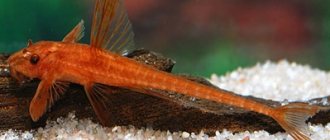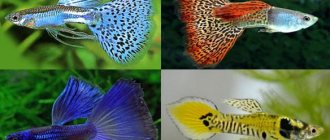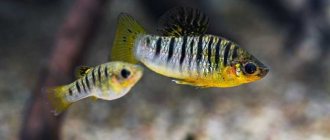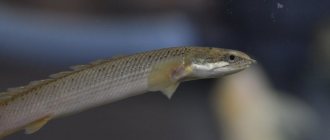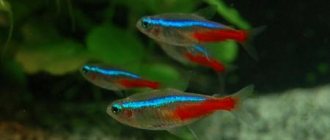Bettas are the most beautiful and diverse freshwater aquarium inhabitants. Despite the rather modest appearance of wild bettas, they have settled in domestic ponds around the world and have taken on impossibly beautiful breeding forms. The historical homeland of the betta fish is Thailand, where they live in stagnant waters or reservoirs with minimal current. All types betas have a labyrinthine organ that allows them to breathe atmospheric air. Therefore, the aquarium should be closed not with a lid, but with a net, so that the pet does not suffocate, but also does not jump out of the aqua house.
Varieties
The betta fish was first selected in 1910, giving it a colored color. Today there are more than 10 species of betta. They differ from each other in color:
- plain (red, yellow, white, black, blue, turquoise, purple);
- two-color (the color of the fins differs from the body color);
- multicolor (marble color, butterfly, dragon).
And also by the type of fins.
| Betta Over Halfmoon |
Betta crowntail |
| Short-tailed cockerel (Betta Plakat) |
| Veiltail cockerel (Betta Veiltail) |
| Delta-tailed Betta (Betta Super Delta) |
Betta Double Tail |
| Elephant-eared cockerel (Dumbo) (Betta Dumbo) |
What to choose
Before choosing a container in which your betta will spend the rest of his life, you need to know about your pet's needs. There is a myth that in their natural environment, Betta fish live in cloudy, shallow puddles, so they do not require special conditions or large volumes. This opinion is complemented by the contents in pet stores - more often than not, bettas are kept in mini-aquariums like glasses or glasses. But this is not so, bettas vitally need free space for swimming and clean water for a healthy life, which are provided by a large aquarium.
But a mini-aquarium is also useful, but not for permanent living. They breed fry or place sick fish for a quarantine period.
A tank with a waterfall is not suitable, as this is an unnatural feature for fighting fish. In the natural environment, cockerels do not encounter such flows of water, so they feel uncomfortable among the constant noise and splashing.
Compatibility of cockerels with other fish
A cockerel can live in an aquarium with other fish, but it is worth considering similar conditions of detention, nutrition and its aggressiveness. Small fish and representatives with large fins do not get along with the betta, and even eats snails.
| Get along well | They get along, but there are rare fights | Incompatible |
|
|
|
general description
The fish are small in size and usually do not grow more than 5 cm, but they stand out for the brightness and splendor of their fins and tails. Natural coloration is light olive or gray with dark stripes, but breeders have developed new variations of blue, purple, green, red, orange, black, white, yellow and cream. The color can be one-color, two-color or with a transition of many shades. There are varieties in size and shape of fins.
Aesthetically, males are much more attractive than females, but they are also hot-tempered. Bettas are called fighting fish, as they behave aggressively with their relatives, and two males in the same aquarium can fatally injure each other. This trait of their character was used at the beginning of the 19th century, when this species of fish began to be bred for fights with monetary stakes. They were given the name for the cockiness characteristic of roosters.
But such a disadvantage as aggressiveness is compensated by a pronounced paternal instinct and the fact that they are convenient to keep due to their unpretentiousness in food and conditions.
Proper care will ensure that cockerels live for two and a half years, and some long-livers are even 3 years old.
How to distinguish a male from a female betta
Adult betta fish have fairly distinct sex differences. The male is larger, has a brighter color, and has longer fins. Until 2 months of age, it is much more difficult to distinguish a female from a male, but there are still several differences:
- the female has a wide and round ventral fin;
- a more rounded abdomen, on which the ovipositor (white dot) is visible;
- she is calmer and less aggressive.
Conditions of detention
Caring for a Siamese betta fish is simple and even a novice aquarist can handle it. The water temperature should be 24–27 degrees, ph should be 6.0–8.0, and its hardness should be within the range of 5–35 dGH. But in practice, deviations from these indicators are possible; the betta fish will easily tolerate this without harm to itself.
Keeping and caring for a fish seems all the more uncomplicated when you find out that keeping betta fish is possible in a simple three-liter jar. Betta splendens have a special respiratory organ that gives them the ability to inhale atmospheric air. All labyrinth fish have it, and it is because of it that this family got its name.
Reproduction
Males mature quickly and are considered sexually mature at the age of 4 months, and begin to reproduce at 6-8 months. A pair of the same breed, and preferably the same color, is suitable for breeding.
Preparation for spawning takes several stages:
- For spawning it is better to equip a separate aquarium. A 4-5 liter tank with a water level of no more than 10-12 cm is suitable. Soil is not placed at the bottom, but plants are needed. The female creates shelter in them, and the male often uses them to build a nest.
- It is advisable to separate the female and male from each other for a week, during which time the female’s abdomen will noticeably become rounder.
- Then the fish are allowed into the spawning aquarium and their temperature is constantly raised to 28-30°C, this stimulates spawning.
- The male will begin to build a nest of foam on the surface of the water, which takes him from 1 to 3 days. If the pair is selected successfully, spawning will begin within a couple of hours.
- During spawning, the male courts the female, picks up the eggs and carries them to the nest.
After the end of spawning, the male drives away the female (she needs to be removed), and he himself takes care of the eggs in the nest: adding bubbles, removing unfertilized eggs. When the fry hatch and begin to swim, the male also needs to be removed, otherwise he may crush the fry.
During one spawning, 200 eggs are released, about a third of them survive.
Lifespan
How long does a rooster fish live in an aquarium environment? This question cannot be answered unambiguously, since the genetics of all fish are different. Many fry do not develop after they begin to swim, move chaotically and die, while others grow successfully. Bettas live in aquariums from one to five years. If the temperature and diet are not observed, the cockerel dies quickly enough.
5 years is a difficult life expectancy to achieve. However, you need to strive for it. Experts recommend monitoring water and nutrition, not overfeeding pets, not housing them with other cockerels, but training them using a mirror placed in the aquarium. Spawning can also extend the life of a pet, so it is sometimes recommended to bring males and females together to produce offspring.
Caring for fry
The fry grow quickly and do not require much effort, you just need to follow some recommendations:
- in the first days, feed brine shrimp or ciliates.
- after 7 days you can already give specialized granulated food for fry or finely chopped tubifex;
- replace ¾ of the water in the aquarium daily;
- in 2-3 weeks it is advisable to sort large individuals from smaller ones;
- At the age of 4 weeks, the fry are transferred to a large aquarium.
About mini aquariums
Small aquariums with a volume of 5 - 20 liters (in the case of freshwater) are usually called mini or nano. This is a fashionable trend in aquarium keeping, because not everyone can afford to place a weighty aqua of 100 or more liters in their apartment. But I still want to admire the fish. There are, however, pitfalls in maintaining a mini aquarium.
Mini aquariums are a broad concept. If on the far left you can keep a cockerel or other fish alone, then those on the right are not suitable for life!
A small aquarium needs to be cleaned much more often than a large one. For clarity, please see the table.
| Aquarium volume (liters) | 4 -5 | 6 — 10 | More than 20 |
| Interval between cleaning (in days) | 3 | 5 | 7 |
When cleaning, replace no more than 1/4 of the water. Because a complete fluid change is a huge stress for pets: fish, snails, even plants! Such cleaning is necessary only in extreme cases, for example, when a reservoir is infected.
Potential Micro Aquarium Vests
A mini aquarium is often decorated with live plants. Which, in turn, can serve well by improving water quality. But they can also ruin it. If you notice darkened leaves or stems, fallen parts of plants or other damage, they should be immediately removed from the water by carefully trimming them with scissors. Otherwise, rotting plants will quickly spoil the water in a small container.
Modern artificial plants perfectly decorate the aquatic interior. You can choose not only plastic greens, but even silk ones!
When placing plants and decorations in the aquarium, do not forget about a sense of proportion and space for the pet to move freely.
Diseases
With good care at home, a cockerel can live for about 3 years. But if the aquarium is poorly maintained, overfed or fed with live food, there is a risk that the betta will get sick.
Diseases can lead to the death of a pet, so you should pay attention to the appetite and behavior of the fish, because these are the first signs of any ailment.
Fin rot:
- Symptoms. The edges of the fins first become dull, then erosion appears, which grows intensively over the entire surface of the fin. Then the process of rotting occurs, and the fin disintegrates.
- Causes. The causative agent of the disease is the bacterium Pseudomonas. It occurs due to poor quality or untimely cleaning of the aquarium, when feeding contaminated food or introducing infected fish and plants.
- Treatment is carried out with salt baths and streptocide. It is also important to disinfect the aquarium, change some of the water, and rinse the plants and soil.
Costiosis:
- Symptoms. A gray spot with copious mucus secretion and clouding of the skin are formed.
- Causes. The parasite is caused by a flagellate, which can be introduced into an aquarium with live food or infected fish.
- Treatment is carried out with furazalidone and malachite green. In this case, it is necessary to change the water by 20-30% every day. As a rule, fish recover within a week.
Dropsy:
- Symptoms are a swollen belly, raised scales, redness of the fins and abdomen, loss of appetite, apathy.
- Causes. Incorrect feeding of fish, supplementary feeding, infections.
- For treatment, use Bicillin 5, white streptocide, and a weak solution of potassium permanganate.
Ichthyophthiriasis:
- Symptoms. Small white dots (similar to semolina grains) appear on the fish's head, which spread throughout the body. Lethargy, loss of appetite, swims in jerks.
- Causes. Introduced into the aquarium with new fish or plants. The culprit may also be live food contaminated with ichthyophthyriasis.
- Treatment is carried out with salt baths, malachite green, bicillin 5, antipar preparations.
By following all the recommendations for caring for a cockerel, the fish will delight you with its beauty, absence of diseases and large offspring.
Some tips
A cockerel that was not kept properly before spawning, that is, it was not fed enough, can eat caviar. The same behavior is observed in young fish that were first placed for spawning. In the future, this goes away in most individuals.
Cockerel fish
When buying fish, you should not choose the largest and brightest individuals, this indicates their age. The larger the cockerel, the older it is, which means it will live less and may not produce healthy offspring.
Aeration should not be turned on in the spawning tank; it can ruin the entire breeding process. The male himself makes bubbles for the nest from the air, and actively purging the water with oxygen will only disturb him.
In an aquarium containing fish with veil fins, there should be no objects with sharp edges that could damage their long fins. Therefore, it is better to refrain from decorating the bottom with different castles and grottoes.
This species is one of the most successful in terms of selection; many colors and fish with different fins have been bred. The table of contents of books on the selection of aquarium species necessarily includes the genus Betta.
Feeding
Betta cockerels are quite picky about food. They eat not only dry food, but also live and frozen food. It is important to know that live food should predominate in the diet. Small bloodworms, tubifex worms, and daphnia are suitable. As a treat, you can sometimes give earthworms, which will need to be crushed, or snails - here coils without shells are suitable.
Usually the fish are fed 1 or 2 times a day. Enough food should be given so that the fish can eat it completely within 10 minutes. If anything remains, it must be removed immediately so that the food does not decompose. Since a betta can easily become obese, overfeeding is not recommended. You need to have a fasting day every week.


